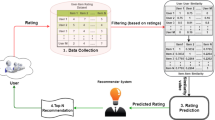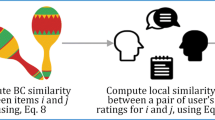Abstract
The item-based collaborative filtering technique recommends an item to the user from the rating of k-nearest items. Generally, a random value of k is considered to find nearest neighbor from item-item similarity matrix. However, consideration of a random value for k intuitively is not a rational approach, as different items may have different value of k nearest neighbor. Sparsity in the data set is another challenge in collaborative filtering, as number of co-rated items’ may be few or zero. Due to the above two reasons, collaborative filtering provides inaccurate recommendations, because the predicted rating may tend towards the Mean. The objective of the proposed work is to improve the accuracy by mitigating the above issues. Instead of using a random value of k, we use the most similar neighbor for each target item so as to predict the target item, since finding k for different target item is computationally expensive. Bhattacharyya Coefficient is used as a similarity measure to handle sparsity in the dataset. The performance of the proposed algorithm is tested the datasets of MovieLens and Film Trust, and experimental results reveal better prediction accuracy than the best of the prevalent prediction approaches exist in literature.






















Similar content being viewed by others
Explore related subjects
Discover the latest articles, news and stories from top researchers in related subjects.References
Recommender systems. http://www.cs.carleton.edu/cs_comps/0607/recommend/recommender/modelbased.htmlhttp://www.cs.carleton.edu/cs_comps/0607/recommend/recommender/modelbased.html, [Online; accessed 17-August-2019]
Choi K, Suh Y (2013) A new similarity function for selecting neighbors for each target item in collaborative filtering. Knowl-Based Syst 37:146–153
Karypis G (2001) Evaluation of item-based top-n recommendation algorithms. In: Proceedings of the Tenth international conference on information and knowledge management, CIKM ’01, pp 247–254
Liu H, Hu Z, Mian AU, Tian H, Zhu X (2014) A new user similarity model to improve the accuracy of collaborative filtering. Knowl-Based Syst 56:156–166
Collaborative filtering. https://en.wikipedia.org/wiki/Collaborative_filteringhttps://en.wikipedia.org/wiki/Collaborative_filtering, [Online; accessed 12-November-2017]
Comparison of user-based and item-based collaborative filtering. [Online; accessed 17-August-2019]. https://medium.com/@wwwbbb8510/comparison-of-user-based-and-item-based/-collaborative-filtering-f58a1c8a3f1dhttps://medium.com/@wwwbbb8510/comparison-of-user-based-and-item-based/-collaborative-filtering-f58a1c8a3f1dhttps://medium.com/@wwwbbb8510/comparison-of-user-based-and-item-based/-collaborative-filtering-f58a1c8a3f1d
Sarwar B, Karypis G, Konstan J, Riedl J (2001) Item-based collaborative filtering recommendation algorithms. In: Proceedings of the 10th international conference on World Wide Web, ACM, pp 285–295
Yang Z, Wu B, Zheng K, Wang X, Lei L (2016) A survey of collaborative filtering-based recommender systems for mobile internet applications. IEEE Access 4:3273–3287
Linden G, Jacobi J, Benson E (2001) Collaborative recommendations using item-to-item similarity mappings. [Google Patents]
Deshpande M, Karypis G (2004) Item-based top-n recommendation algorithms. ACM Trans Inf Syst 22(1):143–177
Patra BK, Launonen R, Ollikainen V, Nandi S (2015) A new similarity measure using bhattacharyya coefficient for collaborative filtering in sparse data. Knowl-Based Syst 82:163–177
Li D, Miao C, Chu S, Mallen J, Yoshioka T, Srivastava P (2018) Stable Matrix Approximation for Top-N Recommendation on Implicit Feedback Data
Xu J, Man H (2011) Dictionary learning based on laplacian score in sparse coding. In: Machine learning and data mining in pattern recognition - 7th international conference, pp 253–264
Bobadilla J, Hernando A, Ortega F, Gutiérrez A (2012) Collaborative filtering based on significances. Inf Sci 185(1):1–17
Ricci F, Rokach L, Shapira B, Kantor PB (2010) Recommender systems handbook, 1st edn. Springer, New York
Lu J, Yue J, Zhu L, Li G (2019) Variational mode decomposition denoising combined with improved bhattacharyya distance. Measurement 151:107283
Wu J, Chen L, Feng Y, Zheng Z, Zhou M, Wu Z (2013) Predicting quality of service for selection by neighborhood-based collaborative filtering. IEEE Trans Systems, Man, and Cybernetics: Systems 43 (2):428–439
Herlocker J, Konstan JA, Riedl J (2002) An empirical analysis of design choices in neighborhood-based collaborative filtering algorithms. Inf Retr 5:287–310
Herlocker JL, Konstan JA, Borchers A, Riedl J (1999) An algorithmic framework for performing collaborative filtering. In: Proceedings of the 22nd annual international ACM SIGIR conference on research and development in information retrieval, pp 230–237
Kim H-N, Ji A-T., Kim H-J, Jo G-S (2007) Error-Based collaborative filtering algorithm for Top-N recommendation
Ahn HJ (2008) A new similarity measure for collaborative filtering to alleviate the new user cold-starting problem. Inf Sci 178(1):37–51
i Mansilla AT, de la Rosa i Esteva JL (2012) Asknext: an agent protocol for social search. Inf Sci 190:144–161
Shen K, Liu Y, Zhang Z, Lu W (2017) Modified similarity algorithm for collaborative filtering. In: Uden L, Ting I-H (eds) Knowledge management in organizations. Springer International Publishing, pp 378–385
Palak R, Nguyen NT (2017) An effective collaborative filtering based method for movie recommendation, pp 149–159
Boratto L, Carta S, Fenu G (2017) Investigating the role of the rating prediction task in granularity-based group recommender systems and big data scenarios. Inf Sci 378:424–443
Koohi H, Kiani K (2017) A new method to find neighbor users that improves the performance of collaborative filtering. Expert Syst Appl 83:30–39
Stephen SC, Xie H, Rai S (2017) Measures of similarity in memory-based collaborative filtering recommender system: A comparison. In: Proceedings of the 4th Multidisciplinary International Social Networks Conference, ACM, pp 32:1–32:8
Liu Y, Feng J, Lu J (2017) Collaborative filtering algorithm based on rating distance. In: Proceedings of the 11th International Conference on Ubiquitous Information Management and Communication, ACM, pp 66:1–66:7
Ai J, Li L, Su Z, Wu C (2017) Online-rating prediction based on an improved opinion spreading approach. In: 29Th chinese control and decision conference
Birtolo C, Ronca D (2013) Advances in clustering collaborative filtering by means of fuzzy c-means and trust. Expert Syst Appl 40(17):6997–7009
Ghazarian S, Nematbakhsh MA (2015) Enhancing memory-based collaborative filtering for group recommender systems. Expert Syst Appl 42(7):3801–3812
Guo G (2013) Integrating trust and similarity to ameliorate the data sparsity and cold start for recommender systems. In: Seventh ACM conference on recommender systems, RecSys ’13, pp 451–454
Guo G, Zhang J, Thalmann D (2014) Merging trust in collaborative filtering to alleviate data sparsity and cold start. Knowl-Based Syst 57:57–68
Sun D, Luo Z, Zhang F (2011) A novel approach for collaborative filtering to alleviate the new item cold-start problem. In: 11th International Symposium on Communications and Information Technologies, ISCIT, pp 402–406
Jorge AM, Vinagre J, Domingues M, Gama J, Soares C, Matuszyk P, Spiliopoulou M (2017) Scalable online Top-N recommender systems. Springer International Publishing
Geuens S, Coussement K, De Bock KW (2018) A framework for configuring collaborative filtering-based recommendations derived from purchase data. Eur J Oper Res 265(1):208–218
Adamopoulos P (2013) Notes on recommender systesm: a survey of state-of-the-art algorithms, beyond rating prediction accuracy approaches and business value perspectives
Lohr SL (2009) Sampling: Design and Analysis. 2nd Edn, Cengage Learning
Bobadilla J, Ortega F, Hernando A (2012) A collaborative filtering similarity measure based on singularities. Inform Process Manage 48(2):204–217
Liu Y, Feng J, Lu J (2017) Collaborative filtering algorithm based on rating distance. In: Proceedings of the 11th International Conference on Ubiquitous Information Management and Communication, pp 1–7
Cacheda F, Carneiro V, Fernández D, Formoso V (2011) Comparison of collaborative filtering algorithms: Limitations of current techniques and proposals for scalable, high-performance recommender systems. ACM Trans Web 5(1):2:1–2:33
Bilge A, Kaleli C (2014) A multi-criteria item-based collaborative filtering framework. In: 11th international joint conference on computer science and software engineering (JCSSE), pp 18– 22
Hui S, Pengyu L, Kai Z (2011) Improving item-based collaborative filtering recommendation system with tag. In: 2nd International Conference on Artificial Intelligence, Management Science and Electronic Commerce (AIMSEC), pp 2142–2145
Wen J, Zhou W (2012) An improved item-based collaborative filtering algorithm based on clustering method. J Compute Inform Syst, pp 571–578
Koohi H, Kiani K, new method to find neighbor users A (2017) That improves the performance of collaborative filtering. Expert Syst Appl 83:30–39
Ye F, Zhang H (2016) A collaborative filtering recommendation based on users’ interest and correlation of items. In: International conference on audio, language and image processing (ICALIP), pp 515–520
Suryakant T, Mahara A (2016) New similarity measure based on mean measure of divergence for collaborative filtering in sparse environment. Procedia Computer Science 89:450–456
Ayub M, Ghazanfar MA, Maqsood M, Saleem A (2018) A jaccard base similarity measure to improve performance of cf based recommender systems. In: International conference on information networking (ICOIN), IEEE, pp 1–6
Al-Bashiri H, Abdulgabber MA, Romli A, Kahtan H An improved memory-based collaborative filtering method based on the topsis technique, PloS One 13 (10)
Ding Y, Li X (2005) Time weight collaborative filtering. In: Proceedings of the 14th ACM international conference on Information and knowledge management, ACM, pp 485–49
Zhang Z-P, Kudo Y, Murai T, Ren Y-G (2019) Enhancing recommendation accuracy of item-based collaborative filtering via item-variance weighting. Appl Sci 9(9):1928
Gao M, Wu Z, Jiang F (2011) Userrank for item-based collaborative filtering recommendation. Inf Process Lett 111(9):440– 446
Jain A, Singh P, Dhar J (2019) Multi-objective item evaluation for diverse as well as novel item recommendations. Expert Systems with Applications 139:112857
Linden G, Smith B, York J (2003) Amazon.com recommendations: Item-to-item collaborative filtering. IEEE Internet Computing 7(1):76–80
Paterek A (2007) Improving regularized singular value decomposition for collaborative filtering. In: Proceedings of KDD cup and workshop, vol 2007, pp 5–8
Lin D (1998) An information-theoretic definition of similarity. In: Proceedings of the Fifteenth international conference on machine learning, pp 296–304
Alqadah F, Reddy CK, Hu J, Alqadah HF (2015) Biclustering neighborhood-based collaborative filtering method for top-n recommender systems. Knowl Inf Syst 44(2):475–491
Gunawardana A, Shani G (2009) A survey of accuracy evaluation metrics of recommendation tasks. J Mach Learn Res 10:2935–2962
Venables WN, Ripley BD (2002) Modern applied statistics with S, 4th edn. Springer, New York
Givens GH, Hoeting JA (2005) Computational Statistics. 2nd Edn, Wiley
Martinez WL, Martinez AR (2007) Computational statistics handbook with MATLAB. 2nd Edn, Chapman and Hall/CRC
Author information
Authors and Affiliations
Corresponding author
Additional information
Publisher’s note
Springer Nature remains neutral with regard to jurisdictional claims in published maps and institutional affiliations.
Rights and permissions
About this article
Cite this article
Singh, P.K., Sinha, M., Das, S. et al. Enhancing recommendation accuracy of item-based collaborative filtering using Bhattacharyya coefficient and most similar item. Appl Intell 50, 4708–4731 (2020). https://doi.org/10.1007/s10489-020-01775-4
Published:
Issue Date:
DOI: https://doi.org/10.1007/s10489-020-01775-4




